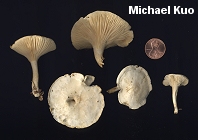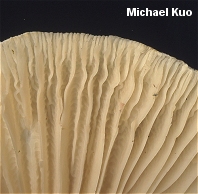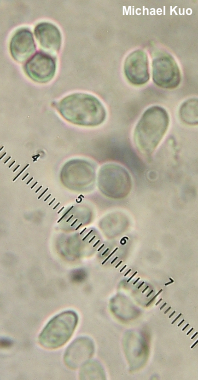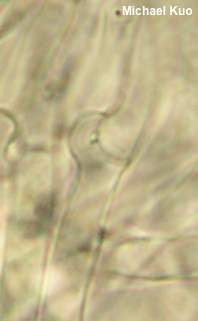| Major Groups > Gilled Mushrooms > Pale-Spored > Clitocyboid Mushrooms > Clitocybe hygrophoroides |

|
[Basidiomycota > Agaricales > Tricholomataceae > Clitocybe . . . ] Clitocybe hygrophoroides by Michael Kuo, 26 October 2022 Because it is reminiscent of some waxy caps (perhaps something like Cuphophyllus virgineus, or Hygrophorus chrysodon) this eastern North American clitocyboid mushroom is named "hygrophoroides"—but its cap and stem are dry, and the resemblance is only superficial. Look for Clitocybe hygrophoroides under eastern white pine in September and October. Clitocybe variabilis is a very similar species from the Pacific Northwest and California; it features a whiter spore print, and caps that turn greenish when dried for the herbarium. The European species Clitocybe nivea is also very similar. Description: Ecology: Saprobic; growing scattered or gregariously in the duff of eastern white pine; September and October; originally described from Michigan (Bigelow 1965); distribution uncertain, but possibly widely distributed east of the Rocky Mountains, throughout the natural and planted range of eastern white pine. The illustrated and described collection is from Illinois. Cap: 2–5 cm; convex with an inrolled margin, becoming flat, broadly bell-shaped, or slightly centrally depressed, with an even to wavy margin; bald; dry; soft; sometimes developing cracks with age; white to buff. Gills: Running down the stem; close or nearly distant; often forking; developing wrinkled cross-veins; short-gills frequent; buff, becoming slightly pinkish with age. Stem: 2–5 cm long; up to 1 cm thick; more or less equal; bald or with a whitish sheen; buff; basal mycelium spongy and white. Flesh: Fairly thick; soft; whitish; unchanging when sliced. Odor and Taste: Odor fragrant and sweet. Taste not distinctive. Chemical Reactions: KOH on cap surface negative to yellowish. Spore Print: White to creamy. Microscopic Details: Spores 5–8 x 4–5 µm; ellipsoid, with an apiculus; smooth; hyaline in KOH; inamyloid. Basidia 35–45 x 5-7; clavate; primarily 4-sterigmate. Cystidia not found. Pileipellis a cutis; elements 3–6 µm wide, smooth, hyaline in KOH. Clamp connections present. REFERENCES: Bigelow, 1965. (Bigelow, 1982; Gregory, 2007.) Herb. Kuo 10300404. This site contains no information about the edibility or toxicity of mushrooms. |
© MushroomExpert.Com |
|
Cite this page as: Kuo, M. (2022, October). Clitocybe hygrophoroides. Retrieved from the MushroomExpert.Com Web site: http://www.mushroomexpert.com/clitocybe_hygrophoroides.html |



